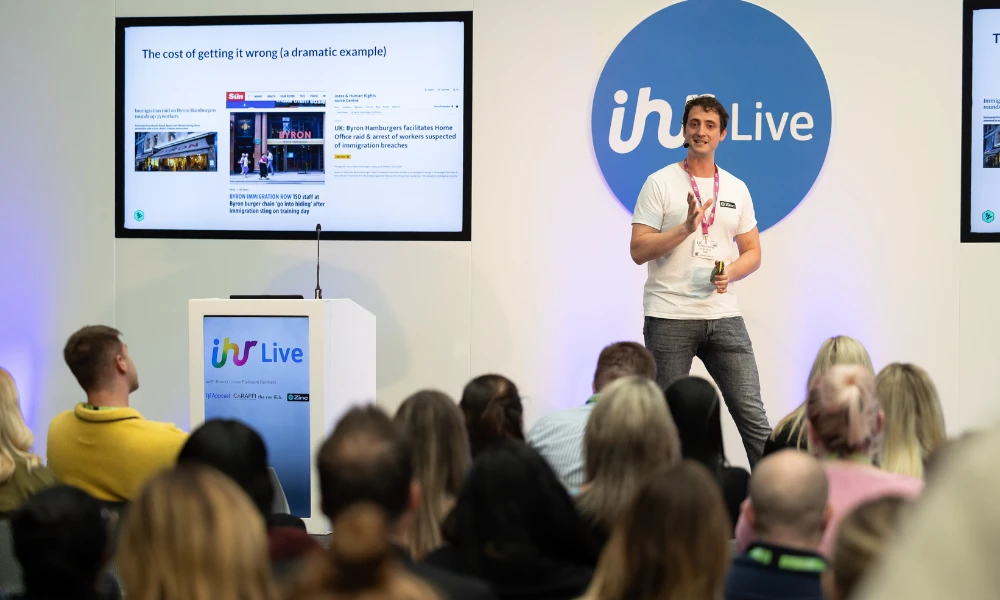IHR

07 June 2023
Onboarding

Setting recruitment goals: what everyone needs to know for 2023
It’s the start of a new year – a time to refresh, reset and re-energise. One thing that’s top of mind for most recruiters is which recruitment goals should be prioritised. This is key for measuring a recruiter performance, hiring the right talent and more.
To really understand how you and your team are performing, it’s essential to set – and track – recruitment goals.
What exactly are recruitment goals and which ones should you be setting? Greenhouse explores these questions and share some insights from Maria Culbertson, Senior Manager of Talent Planning & Acquisition and Michelle Yoshihara, Manager of Talent Planning at Greenhouse.
What are recruitment goals?
Recruitment goals – also known as recruitment KPIs or hiring goals – are the metrics that monitor both what and how a talent acquisition team is doing. You may find it beneficial to track activities like the number of phone screens a recruiter conducts or the number of applications they review each day so that you know how your team is spending their time. However, you’ll probably get more value out of outcome-based goals that help you understand the effectiveness and impact of your talent acquisition team. “If there’s a particular goal that the team is underperforming in, that can indicate that a team might need to change their strategy of pinpoint where additional resources might be needed”, said Maria.
Why should you set recruitment goals?
There are several reasons for setting recruitment goals, according to Maria and Michelle. First, “setting hiring goals ensures that your TA team has clear expectations of what they should be aiming for and focused on in their day-to-day work”, said Maria. “It also allows team manager to equitably manage and asses performance across the team by tracking progress toward goals.”
Michelle added that, “hiring goals ensure you have a healthy hiring function whose output propels the business toward its goals”. In other words – setting recruitment goals ultimately helps your company be more successful!
What are some examples of recruitment goals?
Some examples of recruitment goals you might want to set for your team include:
- Days to Offer (generally measured between when a candidate first applies for a role and when you extend an offer to a candidate)
- Time to Fill (generally measured between when you first post a job and the date when a candidate accepts an offer)
For time-based recruitment goals like these, your first step is to get a baseline of how long it takes to extend an offer or fill a role. Once you’ve established a baseline, you might start to look at these more granularly and see if you can identify any specific stages of types of candidates that take more time than average and look for ways to become more efficient.
- Offer Acceptance Rate (generally measured by the number of candidates who accept an offer made by your company divided by the total number of offers extended)
While the Offer Acceptance Rate can be a straightforward quantitative metric, you might also want to add a qualitative element to it as well. Some companies do this by asking candidates who reject an offer to share a brief explanation of why. Tracking these responses over time can help you understand whether there’s an issue with your compensation, your hiring process or even the way you’re communicating your company culture or values.
- Candidate Satisfaction Rate (generally measured by asking candidates to grade how satisfied they are with the application process or how likely they are to recommend the company to someone else)
- Hiring Manager Satisfaction Rate (similar to Candidate Satisfaction Rate, but it surveys hiring managers on how satisfied they are with the hiring process)
You might choose to measure these satisfaction rates similarly to net promoter scores (NPS) – anyone who gives below a 6 is considered a detractor, scores of 7 and 8 are considered neutral and 9 and 10 are considered promoters. You might also collect qualitative input by asking respondents to answer an open-ended question about why they gave a specific score.
- % of candidates at the initial screen stage that comes from diversity sourcing efforts
- % of candidates at the onsite stage that comes from diversity sourcing efforts
If your company is committed to diversity, equity and inclusion (DE&I), you will likely find it helpful to set a few recruitment goals that show how you’re tracking towards those efforts. Goals like the percentage of candidates at different stages that came from diversity sourcing efforts also give you insight into which sources are most effective.
- Hires Made Against Team Capacity (measured by the number of hires you made over a period of time divided by the number of hires your team is expected to make. This is most commonly based on an average number of hires made per TA Manager.)
If your hires to capacity is at or near 100%, your team is delivering the amount expected based on capacity. If this number is under 100%, your team is not delivering at the amount that’s expected. This could be due to factors outside the TA team’s control like hiring freezes or pauses, or it could be a result of TA managers not performing at the right level. If you find yourself in this situation, you can diagnose what led to this outcome.
If the reason is within your team’s control, focus your efforts on increasing the number of hires per TA manager. And if this number is over 100%, your team is overdelivering on the amount that’s expected. While it’s always exciting to see over-performance, it could also indicate poor planning in terms of the number of TA managers needed to make the hires that are being asked for and might lead to burn-out. If this is consistently over 100%, it’s worth considering adding onto the TA team.
How can you get started with setting recruitment goals?
Now that you know why setting recruitment goals is important and have an overview of some of the most common ones, you might be wondering what you can do to get started with setting and tracking them on your team.
Maria outlined the following steps:
- Use whatever historical data you do have to help understand how your team has performed in this area in the past. This can help ensure that the goals you set are reasonable and achievable.
- Ensure team-wide understanding and obtain buy-in.
- Track teamwide progress toward goals often.
- Discuss individual progress toward goals in performance development conversation (quarterly reviews, 1:1s, etc.).
Michelle also shared the following advice: “Make sure you have relevant slices of data to take action. For example, it’s great to report company-wide and if you have massive department, it’s likely more targeted or helpful to report at a department or even sub-department level. All these different slices of the company should be performing in alignment with target metrics, but this gives you a smaller group of people to work with on taking action for improvement.”
Finally, don’t feel like you have to do everything all at once. “Find focus!” advised Michelle. “As you unlock the ability to report on your recruiting process, it can be tempting to deep dive into any and everything. Focus where it counts – where can you and your team have the largest impact? Where are you hurting the most? Which metrics align with the company’s top priorities and how can you improve those?”
Partner

Greenhouse is the hiring software company. More than an ATS, we help businesses become great at hiring through our powerful hiring approach, complete suite of software and services, Hiring Maturity™ methodology and large partner ecosystem – so businesses can hire for what’s next.


